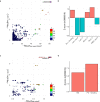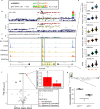This is a preprint.
Colocalization of blood cell traits GWAS associations and variation in PU.1 genomic occupancy prioritizes causal noncoding regulatory variants
- PMID: 37034747
- PMCID: PMC10081269
- DOI: 10.1101/2023.03.29.534582
Colocalization of blood cell traits GWAS associations and variation in PU.1 genomic occupancy prioritizes causal noncoding regulatory variants
Update in
-
Blood cell traits' GWAS loci colocalization with variation in PU.1 genomic occupancy prioritizes causal noncoding regulatory variants.Cell Genom. 2023 May 17;3(7):100327. doi: 10.1016/j.xgen.2023.100327. eCollection 2023 Jul 12. Cell Genom. 2023. PMID: 37492098 Free PMC article.
Abstract
Genome-wide association studies (GWAS) have uncovered numerous trait-associated loci across the human genome, most of which are located in noncoding regions, making interpretations difficult. Moreover, causal variants are hard to statistically fine-map at many loci because of widespread linkage disequilibrium. To address this challenge, we present a strategy utilizing transcription factor (TF) binding quantitative trait loci (bQTLs) for colocalization analysis to identify trait associations likely mediated by TF occupancy variation and to pinpoint likely causal variants using motif scores. We applied this approach to PU.1 bQTLs in lymphoblastoid cell lines and blood cell traits GWAS data. Colocalization analysis revealed 69 blood cell trait GWAS loci putatively driven by PU.1 occupancy variation. We nominate PU.1 motif-altering variants as the likely shared causal variants at 51 loci. Such integration of TF bQTL data with other GWAS data may reveal transcriptional regulatory mechanisms and causal noncoding variants underlying additional complex traits.
Conflict of interest statement
Ethics Declarations
The authors declare no competing interests.
Figures











Similar articles
-
Blood cell traits' GWAS loci colocalization with variation in PU.1 genomic occupancy prioritizes causal noncoding regulatory variants.Cell Genom. 2023 May 17;3(7):100327. doi: 10.1016/j.xgen.2023.100327. eCollection 2023 Jul 12. Cell Genom. 2023. PMID: 37492098 Free PMC article.
-
Genetic colocalization atlas points to common regulatory sites and genes for hematopoietic traits and hematopoietic contributions to disease phenotypes.BMC Med Genomics. 2020 Jun 29;13(1):89. doi: 10.1186/s12920-020-00742-9. BMC Med Genomics. 2020. PMID: 32600345 Free PMC article.
-
Identification of candidate causal cis -regulatory variants underlying electrocardiographic QT interval GWAS loci.bioRxiv [Preprint]. 2024 Mar 27:2024.03.13.584880. doi: 10.1101/2024.03.13.584880. bioRxiv. 2024. Update in: Circ Genom Precis Med. 2025 Jun;18(3):e005032. doi: 10.1161/CIRCGEN.124.005032. PMID: 38585875 Free PMC article. Updated. Preprint.
-
From GWAS to Gene: Transcriptome-Wide Association Studies and Other Methods to Functionally Understand GWAS Discoveries.Front Genet. 2021 Sep 30;12:713230. doi: 10.3389/fgene.2021.713230. eCollection 2021. Front Genet. 2021. PMID: 34659337 Free PMC article. Review.
-
Deciphering the Emerging Complexities of Molecular Mechanisms at GWAS Loci.Am J Hum Genet. 2018 Nov 1;103(5):637-653. doi: 10.1016/j.ajhg.2018.10.001. Am J Hum Genet. 2018. PMID: 30388398 Free PMC article. Review.
References
-
- International Common Disease Alliance. International Common Disease Alliance White Paper v1.0. https://www.icda.bio/ (2020).
Publication types
Grants and funding
LinkOut - more resources
Full Text Sources
Miscellaneous
